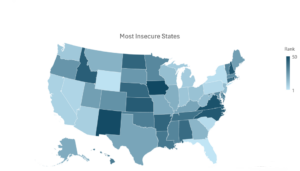The Cybersecurity Landscape: The Most Insecure States in 2024
Jeff Wolverton

When it comes to the 50 states there are many different ways to track which have better cybersecurity measures and which lack them. You may be in a state that is more vulnerable than the one next door due to these many statistics. Whether it’s your personal data or your business’s, these states are the most insecure.
The research team at PivIT Strategy ranked the 50 States for the most insecure cybersecurity states. Our rankings are based on number of reported victims by state population, state cybersecurity grant programs, annual cybersecurity wages, average amount loss per person, and cybersecurity job gap by state.
Key Findings
- States with high salaries don’t correlate perfectly with increased cybersecurity Example: New York has the highest cybersecurity salary but ranks top 5 most insecure.
- Some States like Montana, have one factor bringing down their cybersecurity ranking such as annual wage. While others like Arizona have medium rankings across the board.
- The ranking seems geographically diverse, with states from all corners of the US represented. This indicates that cybersecurity vulnerability is not concentrated in any specific region.
- There appears to be no clear correlation between state size/population and their position in the ranking. Both large and small states are present across the spectrum.
The Most Insecure States in 2024
Where is the most insecure state? The list below shows the rankings based on number of reported victims by state population, state cybersecurity grant programs, annual cybersecurity wages, average amount loss per person, and cybersecurity job gap by state.

The Most Insecure States in 2024
1. Florida

Florida claims the top spot as the most insecure state, primarily due to its Cybersecurity Grant Program budget. Despite a government allocation of nearly $12 million and an estimated population of 21 million, this translates to only $0.56 per person for cybersecurity. In comparison, Vermont spends $7.34 per person. In contribution with bad rankings in multiple other factors has them the most insecure.
2. Wyoming

Wyoming secures the second spot as the most insecure state, attributed to the ratio of cybersecurity professionals to the population. According to BLS and Census data, their ratio stands at 0.0052%, signaling a concerning imbalance. Combined with wage statistics, Wyoming ranks notably low.
3. New York

New York claims the third spot in insecurity, primarily due to its high population. Despite offering the highest average pay for cybersecurity professionals, the sheer size of the population places them in the bottom three for average spending per person on grant programs and the supply/demand for cybersecurity professionals.
4. South Carolina

South Carolina falls into the bottom four for insecurity, driven by a high number of victims compared to the state’s total population and substantial gaps in the supply/demand for cybersecurity professionals. The only stat that they’re not bottom half for is average loss per person where they rank 30th.
5. Pennsylvania

Pennsylvania secures the fifth spot at the bottom due to its average grant spending per person and the supply/demand ratio for cybersecurity workers. Across all statistics, Pennsylvania maintains a consistently low average, positioning it among the least secure states.
The Most Secure States in 2024
1. New Hampshire

New Hampshire is a most secure State primarily attributable to its remarkably high annual wage for cybersecurity professionals. With a grant program spending per person ranking in the top 10 and a commendable standing of 12th in the number of victims compared to the total state population, New Hampshire emerges as a paragon of cybersecurity resilience.
2. Virginia

Virginia secures the 46th position in security due to its outstanding employment by population ratio. With a population of approximately 8.6 million, Virginia surpasses larger states like Texas in the number of cybersecurity professionals, further bolstering its security measures. Notably, recent data privacy laws mandating the protection of personal data for all businesses contribute to Virginia’s robust security posture.
3. Rhode Island

Claiming a spot in the top three most secure states, Rhode Island demonstrates excellence across various metrics. Ranking consistently high in all categories, The lowest statistic is the average loss per victim and they maintain a top 50%.
4. New Mexico

Securing one of the top two positions in security, New Mexico distinguishes itself with consistently high rankings across all statistical categories. It excels in employment of cybersecurity professionals by population, ranking in the top 10, and stands among the top 5 in average loss per victim. This comprehensive performance solidifies New Mexico’s status as one of the most secure states.
5. Iowa

Iowa emerges as the undisputed most secure state, boasting impressive statistics across all fronts. With top 5 performances in the number of victims, annual wage of cybersecurity professionals, and average loss per victim, Iowa sets a benchmark for cybersecurity excellence, making it the epitome of a secure state.
Top Considerations for the Most Insecure States
When determining the most insecure state, the assessment heavily relies on the cybersecurity practices and safeguards adopted by individuals and businesses within that state. It’s crucial to acknowledge that even in the most insecure state, there might be individuals diligently adhering to cybersecurity best practices, and conversely, the most secure states may have entities neglecting these practices.
While the provided statistics contribute significantly to evaluating a state’s cybersecurity stance, there are numerous undisclosed factors that play a role due to limited available information. It’s imperative to recognize that the landscape is multifaceted and not entirely captured by the provided metrics.
The key takeaway is to prioritize and elevate your personal and professional cybersecurity practices. In an environment where certain factors might not be quantifiable, ensuring that your cybersecurity measures are robust and up to date becomes paramount. By maintaining a proactive approach, you contribute to your state’s overall cybersecurity resilience, irrespective of the broader statistical landscape.
The Full Data
| State | Number of Victims | Grant Program | Annual Wage | Employment / Population | Loss Per Person | Supply/Demand Ratio | Rank |
| Florida | 6 | 2 | 30 | 34 | 6 | 16 | 1 |
| Wyoming | 13 | 50 | 3 | 1 | 12 | 21 | 2 |
| New York | 23 | 3 | 50 | 22 | 7 | 3 | 3 |
| South Carolina | 12 | 25 | 19 | 11 | 30 | 12 | 4 |
| Pennsylvania | 29 | 7 | 17 | 20 | 31 | 6 | 5 |
| Nevada | 1 | 28 | 25 | 4 | 5 | 48 | 6 |
| California | 4 | 1 | 49 | 24 | 2 | 9 | 7 |
| Arizona | 10 | 11 | 27 | 35 | 9 | 33 | 8 |
| Michigan | 15 | 12 | 20 | 13 | 36 | 30 | 9 |
| Washington | 11 | 13 | 46 | 44 | 11 | 2 | 10 |
| Indiana | 9 | 18 | 4 | 6 | 48 | 18 | 11 |
| Ohio | 27 | 8 | 23 | 18 | 43 | 10 | 12 |
| Wisconsin | 16 | 22 | 21 | 27 | 33 | 15 | 13 |
| West Virginia | 37 | 39 | 11 | 3 | 49 | 1 | 14 |
| New Jersey | 21 | 6 | 42 | 43 | 14 | 14 | 14 |
| Georgia | 22 | 10 | 36 | 38 | 16 | 22 | 16 |
| Montana | 33 | 44 | 7 | 5 | 27 | 4 | 17 |
| Illinois | 28 | 5 | 32 | 23 | 26 | 32 | 18 |
| Alaska | 3 | 48 | 18 | 9 | 23 | 47 | 19 |
| Missouri | 24 | 20 | 5 | 41 | 32 | 26 | 19 |
| Kentucky | 45 | 30 | 12 | 12 | 46 | 7 | 21 |
| Texas | 17 | 4 | 34 | 37 | 18 | 17 | 21 |
| Maine | 34 | 42 | 6 | 7 | 40 | 27 | 23 |
| Utah | 18 | 29 | 28 | 36 | 15 | 5 | 23 |
| South Dakota | 7 | 46 | 16 | 45 | 1 | 42 | 25 |
| Oregon | 19 | 23 | 38 | 15 | 19 | 19 | 26 |
| Colorado | 5 | 17 | 35 | 47 | 13 | 43 | 27 |
| Massachusetts | 30 | 9 | 39 | 39 | 10 | 35 | 28 |
| Maryland | 8 | 16 | 48 | 49 | 8 | 34 | 29 |
| Minnesota | 39 | 21 | 33 | 30 | 35 | 8 | 30 |
| Vermont | 31 | 49 | 2 | 14 | 21 | 50 | 31 |
| Mississippi | 50 | 35 | 1 | 8 | 50 | 23 | 31 |
| Oklahoma | 35 | 31 | 15 | 10 | 38 | 38 | 33 |
| Hawaii | 26 | 40 | 31 | 17 | 20 | 39 | 34 |
| Louisiana | 46 | 24 | 9 | 2 | 47 | 46 | 35 |
| Delaware | 2 | 45 | 43 | 48 | 4 | 11 | 36 |
| Tennessee | 36 | 19 | 24 | 25 | 39 | 13 | 37 |
| Connecticut | 20 | 26 | 41 | 28 | 17 | 25 | 38 |
| Alabama | 43 | 27 | 26 | 40 | 3 | 44 | 39 |
| Nebraska | 42 | 37 | 13 | 21 | 44 | 29 | 40 |
| North Dakota | 48 | 47 | 8 | 19 | 34 | 31 | 41 |
| Arkansas | 44 | 34 | 10 | 16 | 42 | 41 | 41 |
| Idaho | 32 | 38 | 22 | 32 | 24 | 49 | 43 |
| Kansas | 49 | 32 | 14 | 29 | 29 | 45 | 44 |
| North Carolina | 41 | 15 | 40 | 42 | 37 | 24 | 45 |
| New Hampshire | 38 | 41 | 47 | 33 | 25 | 20 | 46 |
| Virginia | 14 | 14 | 44 | 50 | 22 | 36 | 47 |
| Rhode Island | 40 | 43 | 29 | 31 | 28 | 40 | 48 |
| New Mexico | 25 | 36 | 37 | 46 | 41 | 28 | 49 |
| Iowa | 47 | 33 | 45 | 26 | 45 | 37 | 50 |
Methodology
The research team at PivIT Strategy compared the 50 states across 7 metrics to determine which states were the most insecure in cybersecurity.
- Number of Victims by State Population
- State and Local Cybersecurity Grant Program by Population
- Annual Wage of Information Security Analysts
- Supply and Demand of Cybersecurity Professionals
- Employment of Information Security Analysts by State Population
- Average Loss Per Victim by State Population
- US State Privacy Legislation
- State Population Estimates
Jeff Wolverton
Jeff, the CEO of PivIT Strategy, brings over 30 years of IT and cybersecurity experience to the company. He began his career as a programmer and worked his way up to the role of CIO at a Fortune 500 company before founding PivIT Strategy.
